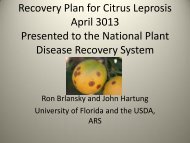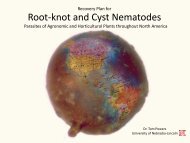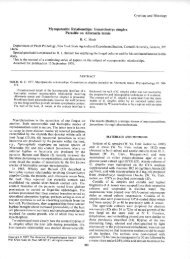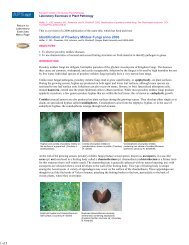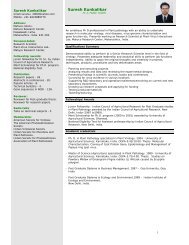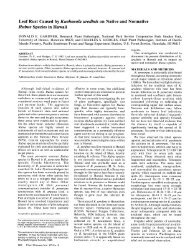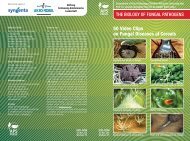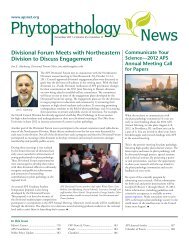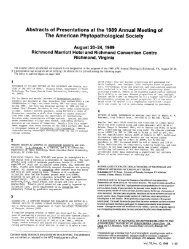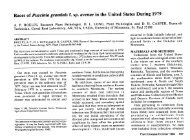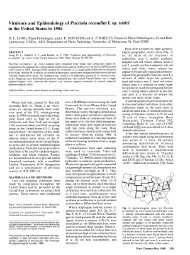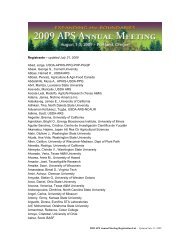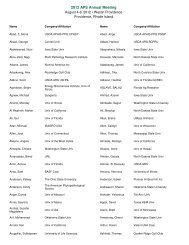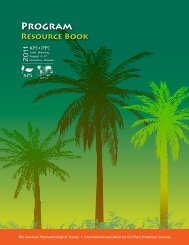Annual Meeting Program Book - American Phytopathological Society
Annual Meeting Program Book - American Phytopathological Society
Annual Meeting Program Book - American Phytopathological Society
Create successful ePaper yourself
Turn your PDF publications into a flip-book with our unique Google optimized e-Paper software.
The emerging field of microbial forensics is focused on<br />
the tracing and attribution of criminal activities involving<br />
microbes. An important component of the field is the new<br />
sub-discipline of forensic plant pathology. Speakers will define<br />
and address the goals and objectives of this field, describe<br />
exciting new technological tools for its practice, discuss the<br />
potential roles and contributions of plant pathologists in it,<br />
and lead audience members through its application in a plant<br />
disease case study.<br />
1:00 p.m. Introduction<br />
1:30 p.m. S-6. Critical issues in determining if disease outbreaks<br />
were deliberate attacks on U.S. agriculture.<br />
J. FLETCHER (1). (1) Oklahoma State University,<br />
Stillwater, OK, U.S.A.<br />
2:00 p.m. S-7. Engaging plant pathologists to meet law<br />
enforcement needs. B. BUDOWLE (1). (1) FBI,<br />
DOJ, Quantico, VA, U.S.A.<br />
2:30 p.m. S-8. Role of imagery, spatial pattern analyses,<br />
and sampling in plant pathogen forensics. F. W.<br />
NUTTER, JR. (1). (1) Iowa State University,<br />
Ames, IA, U.S.A.<br />
3:00 p.m. S-9. New molecular tools for microbial forensics<br />
investigations. J. BURANS (1). (1) NBFC, DHS,<br />
Frederick, MD, U.S.A.<br />
3:30 p.m. S-10. Forensics in the trenches: Learning through<br />
exercises. C. THOMAS (1). (1) University of<br />
California-Davis, CA, U.S.A.<br />
Methyl Bromide Alternatives Research: Plant Pathology<br />
Outcomes<br />
1:00 – 3:30 p.m; A105<br />
Section: Plant Disease Management<br />
Organizer: Frank Louws, North Carolina State University,<br />
Raleigh, NC, U.S.A.<br />
Moderator: Carla Garzon, Oklahoma State University,<br />
Stillwater, OK, U.S.A.<br />
Sponsoring Committee: Soil Microbiology and Root Diseases<br />
Methyl bromide has been an important tool to manage<br />
soilborne pathogens in high-value specialty crops. Integrated<br />
research and extension programs were implemented to<br />
enable the industry to transition to alternative chemicals<br />
and alternative management practices. This session will<br />
provide an overview on the current status of changing trends<br />
in atmospheric methyl bromide levels. The session will<br />
also educate attendees about the current status of the main<br />
chemical alternatives and methods of applications that have<br />
emerged and about significant advances in developing and<br />
extending discovery research on soil microbial ecology and<br />
the biology, etiology, ecology, and management of soilborne<br />
pathogens.<br />
1:00 p.m. S-11. The ozone hole: Anthropogenic sources of<br />
methyl bromide and recent data on atmospheric<br />
methyl bromide levels. J. BUTLER (1),<br />
S. Montzka (1). (1) National Oceanic and<br />
Atmospheric Administration, Boulder, CO,<br />
U.S.A.<br />
1:30 p.m. S-12. Current status of chemical alternative<br />
technologies for managing soilborne diseases. J.<br />
NOLING (1). (1) University of Florida, Lake<br />
Alfred, FL, U.S.A.<br />
2:00 p.m. S-13. Towards reduced dependence on fumigants<br />
for management of PruInus replant problems:<br />
Opportunities and challenges. G. BROWNE (1).<br />
(1) USDA-ARS, University of California-Davis,<br />
CA, U.S.A.<br />
2:30 p.m. S-14. Development of a regional transitions<br />
program: From discovery research to extension in<br />
strawberry production. F. LOUWS (1). (1) North<br />
Carolina State University, Raleigh, NC, U.S.A.<br />
3:00 p.m. S-15. Advances in microbial ecology and farming<br />
systems as a replacement for methyl bromide to<br />
manage soilborne diseases. D. CHELLEMI (1).<br />
(1) USDA ARS, Ft. Pierce, FL, U.S.A.<br />
“New” Nuances in Virus-Vector Biology<br />
1:00 – 3:30 p.m.; B113-114<br />
Section: Biology of Pathogens<br />
Organizers/Moderators: Anna Whitfield, Kansas State<br />
University, Manhattan, KS, U.S.A.; Judith Brown, University<br />
of Arizona, Tucson, AZ, U.S.A.<br />
Sponsoring Committee: Virology<br />
With the development of genomic and proteomic<br />
technologies, scientists are beginning to uncover the viral and<br />
vector proteins that are required for virus transmission by<br />
arthropods. This session will highlight new developments in<br />
our understanding of the molecular interactions between plant<br />
viruses and their vectors.<br />
1:00 p.m. S-16. Elucidating the functional role of the<br />
Crinivirus capsid protein(s) in mediating semipersistent<br />
transmission by whitefly vectors. J. NG<br />
(1). (1) University of California, Riverside, CA,<br />
U.S.A.<br />
1:30 p.m. S-17. -Omics for exploring whitefly-Begomovirus<br />
interactions. J. BROWN (1). (1) University of<br />
Arizona, Tucson, AZ, U.S.A.<br />
2:00 p.m. S-18. Vector and virus proteins contributing to<br />
the regulation of Yellow dwarf virus (Luteoviridae)<br />
transmission by aphids. F. GILDOW (1), S. Gray<br />
(2). (1) Penn State, University Park, PA, U.S.A.;<br />
(2) USDA-ARS, Cornell University, Ithaca, NY,<br />
U.S.A.<br />
2:30 p.m. S-19. Exploiting vector specificity to inhibit<br />
Tospovirus transmission. T. GERMAN (1). (1)<br />
University of Wisconsin, Madison, WI, U.S.A.<br />
3:00 p.m. S-20. Molecular and cellular interactions<br />
between rhabdoviruses and their insect hosts. A.<br />
WHITFIELD (1). (1) Kansas State University,<br />
Manhattan, KS, U.S.A.<br />
17<br />
sundaY



